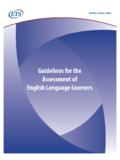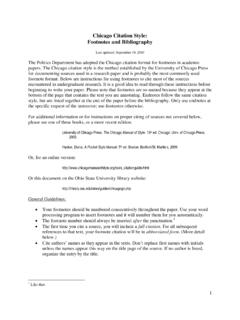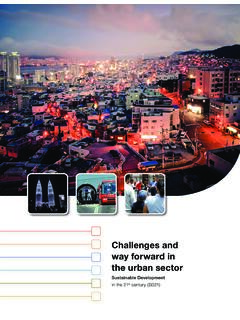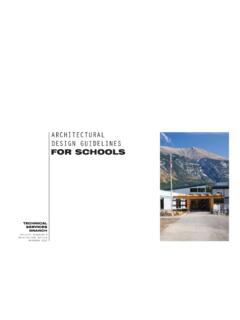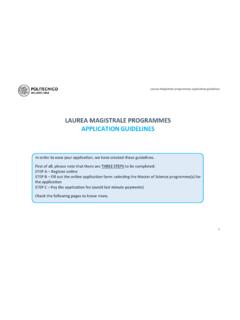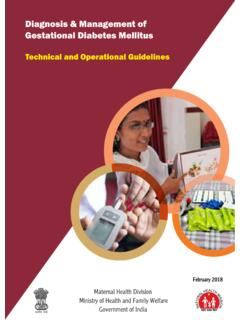Transcription of Polynuclear aromatic hydrocarbons in Drinking-water - World …
1 WHO/SDE/ onlyPolynuclear aromatic hydrocarbonsin Drinking-waterBackground document for development ofWHO guidelines for Drinking-water Quality_____Originally published in guidelines for Drinking-water quality, 2nd ed. Addendum to Vol. 2. Healthcriteria and other supporting information. World Health Organization, Geneva, 1998. World Health Organization 2003 All rights reserved. Publications of the World Health Organization can be obtained from Marketing andDissemination, World Health Organization, 20 Avenue Appia, 1211 Geneva 27, Switzerland (tel: +4122 791 2476; fax: +41 22 791 4857; email: for permission to reproduce or translate WHO publications - whether for sale or fornoncommercial distribution - should be addressed to Publications, at the above address (fax: +41 22791 4806.))
2 Email: designations employed and the presentation of the material in this publication do not imply theexpression of any opinion whatsoever on the part of the World Health Organization concerning thelegal status of any country, territory, city or area or of its authorities, or concerning the delimitation ofits frontiers or mention of specific companies or of certain manufacturers products does not imply that they areendorsed or recommended by the World Health Organization in preference to others of a similar naturethat are not mentioned.
3 Errors and omissions excepted, the names of proprietary products aredistinguished by initial capital World Health Organization does not warrant that the information contained in this publication iscomplete and correct and shall not be liable for any damages incurred as a result of its use2 PrefaceOne of the primary goals of WHO and its member states is that all people, whatevertheir stage of development and their social and economic conditions, have the right tohave access to an adequate supply of safe drinking water.
4 A major WHO function toachieve such goals is the responsibility to propose .. regulations, and to makerecommendations with respect to international health matters .. The first WHO document dealing specifically with public Drinking-water quality waspublished in 1958 as international Standards for Drinking-water . It was subsequentlyrevised in 1963 and in 1971 under the same title. In 1984 1985, the first edition of theWHO guidelines for Drinking-water quality (GDWQ) was published in threevolumes: Volume 1, Recommendations; Volume 2, Health criteria and othersupporting information; and Volume 3, Surveillance and control of communitysupplies.
5 Second editions of these volumes were published in 1993, 1996 and 1997,respectively. Addenda to Volumes 1 and 2 of the second edition were published in1998, addressing selected chemicals. An addendum on microbiological aspectsreviewing selected microorganisms was published in GDWQ are subject to a rolling revision process. Through this process, microbial,chemical and radiological aspects of Drinking-water are subject to periodic review,and documentation related to aspects of protection and control of public Drinking-water quality is accordingly the first edition of the GDWQ, WHO has published information on healthcriteria and other supporting information to the GDWQ.
6 Describing the approachesused in deriving guideline values and presenting critical reviews and evaluations ofthe effects on human health of the substances or contaminants examined in each chemical contaminant or substance considered, a lead institution prepared ahealth criteria document evaluating the risks for human health from exposure to theparticular chemical in Drinking-water . Institutions from Canada, Denmark, Finland,France, Germany, Italy, Japan, Netherlands, Norway, Poland, Sweden, UnitedKingdom and United States of America prepared the requested health the responsibility of the coordinators for a group of chemicals considered in theguidelines, the draft health criteria documents were submitted to a number ofscientific institutions and selected experts for peer review.
7 Comments were taken intoconsideration by the coordinators and authors before the documents were submittedfor final evaluation by the experts meetings. A final task force meeting reviewed thehealth risk assessments and public and peer review comments and, where appropriate,decided upon guideline values. During preparation of the third edition of the GDWQ,it was decided to include a public review via the World wide web in the process ofdevelopment of the health criteria the preparation of health criteria documents and at experts meetings, carefulconsideration was given to information available in previous risk assessments carriedout by the international Programme on Chemical Safety, in its Environmental Health3 Criteria monographs and Concise international Chemical Assessment Documents.
8 TheInternational Agency for Research on Cancer, the joint FAO/WHO Meetings onPesticide Residues, and the joint FAO/WHO Expert Committee on Food Additives(which evaluates contaminants such as lead, cadmium, nitrate and nitrite in addition tofood additives).Further up-to-date information on the GDWQ and the process of their development isavailable on the WHO internet site and in the current edition of the first draft of Polynuclear aromatic hydrocarbons in Drinking-water , Backgrounddocument for the development of the WHO guidelines for Drinking-water Quality,was prepared by J.
9 Kielhorn and A. Boehncke, Germany, to whom special thanks work of the following coordinators was crucial in the development of thisdocument and others in the Addendum:P. Chambon, Health Environment Hygiene Laboratory of Lyon, Lyon,France (inorganic constituents)U. Lund, Water Quality Institute, Horsholm, Denmark,(organicconstituents)H. Galal-Gorchev, Urban Environmental Health, World Health Organization,Geneva, Switzerland (pesticides)E. Ohanian, Environmental Protection Agency, Washington, , USA(disinfectants and disinfection by-products)The coordinators for the overall administrative and technical aspects of this documentwere, respectively, J.
10 Kenny and H. Galal-Gorchev, Urban Environmental Health,WHO, Geneva, Marla Sheffer of Ottawa, Canada, was responsible for the scientific editing of efforts of all who helped in the preparation and finalization of this document,including those who drafted and peer reviewed drafts, are gratefully preparation of this document was made possible by the financial support affordedto WHO by Canada, the European Commission, Japan and the DESCRIPTIONPAHs are a class of diverse organic compounds containing two or more fused aromatic ringsof carbon and hydrogen atoms.










